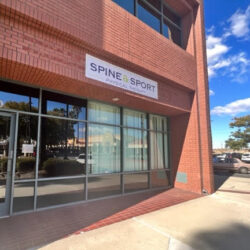The basics of physical therapy
- Physical therapy is a comprehensive approach to care provided by physical therapists using in-person examination, diagnosis, hands-on physical intervention, exercises and education to promote healing or prevent loss of function.
- Physical therapy (PT) helps patients improve mobility, strength, endurance and balance depending on the individualized needs of the patients. It also helps decrease pain and maintain or regain independence.
- PT can improve a variety of disorders and conditions of the body causing pain, stiffness, weakness or movement issues. These can occur due to illness, aging, traumatic injuries, surgery or even normal wear and tear.
- Treatments vary depending on the condition but often include strengthening exercises and balance or flexibility training, coupled with manual therapy and patient education to promote healing and avoid re-injury.
Move forward, faster, fearlessly
What is physical therapy (PT)?
Physical therapy (PT), is a specialized medical profession that provides tailored programs of education and physical intervention to help patients improve mobility, balance, strength, range of motion and other impairments that limit their activities of daily living. PT can also provide ongoing care to maintain optimal quality of movement and level of function.
Physical therapists are experts in treating musculoskeletal conditions, meaning any condition affecting muscles, ligaments, tendons and bones. As such, it can aid in a variety of conditions ranging from back/neck pain, joint-related disorders (such as arthritis), balance problems, post-surgical rehabilitation and more.
The goal of PT is to address the root cause of a patient’s problem in order to decrease pain, improve function and promote full recovery.
When to do physical therapy
Having a coordinated approach to care is critical, so patients should work with their physical therapist to determine the appropriate time to start therapy as well as the appropriate frequency of appointments
Spine & Sport’s philosophy of physical therapy treatment
We take a team approach where therapists, patients and their physicians work together to meet progressive recovery goals. Our treatment philosophy combines skilled hands-on PT, a targeted exercise program, and superior patient motivation and education to achieve the highest outcomes. Our team uses objective measurements to chart patient progress throughout the course of rehab.
Spine & Sport’s emphasis on teaching injury prevention and healthy behaviors helps patients to maintain the improvements made as a result of their physical therapy. This helps them return more rapidly to their work and activities of daily living, while preventing re-injury or future injuries.
What to expect from PT
During the first session, the physical therapist conducts a thorough examination and evaluation. This includes discussing health history information, symptoms, prior treatment and goals of current treatment. Targeted testing will then be completed, which may include assessing pain, strength, balance, range of motion and the integrity of ligaments, nerves and other musculoskeletal structures.
Assessment
This information obtained during the examination aims to assess why someone needs physical therapy. This will then be used to determine the individualized plan of care and the interventions (PT treatments) necessary to achieve short-term and long-term rehabilitation goals.
Care plan & physical therapy sessions
When designing a plan of care, the therapist will take into account everyday movements that are challenging or flare-up symptoms, such as lifting, sitting at work or climbing the stairs, and prescribe exercises that will make those activities easier or less painful. This may include “homework” outside of regular appointments with the therapist that the patient does at home in order to reach treatment goals.
During treatment sessions, therapists may provide hands-on treatment techniques, stretching and strengthening exercises, balance training activities, flexibility training, aerobic conditioning, and therapeutic exercise in water (aquatic therapy). They will lead the patient through the prescribed exercises, providing corrections or assistance as needed. Patients are fully supported and supervised to ensure proper techniques.
Conditions & injuries physical therapy programs target
Our physical therapy programs can assist in a range of disorders and conditions causing pain, stiffness, weakness or movement dysfunction. These can occur due to illness, aging, traumatic injuries, surgery and the accumulation of everyday stresses on the body.
Here are just a few reasons patients may visit a physical therapist
- Treat neck or back pain.
- Treat any joint problems.
- Treat sports injuries with the goal of return to play.
- Rehabilitation post-surgery.
- Recover from workplace injuries to return to or continue employment.
- Maintain a current healthy body and prevent injury.
Benefits of physical therapy
Whether a patient has problems with mobility, motor function, pain or balance, PT can improve overall function and quality of life. Outside of treating the injury itself, physical therapy can enhance cardiovascular functions and lung capacity. Other health issues can be resolved and rehabilitated with physical support and stretches.
For many, physical therapy can replace or reduce the use of medication to treat pain and inflammation. For those patients who want to avoid medication entirely, physical therapists can work with them to determine a treatment plan for their goals.
Timeline of physical therapy progress
One of the most significant questions patients have is how long it will take to recover and the actual timeline of the progress. Because every person’s situation is different, the timeline of recovery is based on the patient’s condition, goals of treatment and progression of the injury’s healing.
A rough sketch for the duration of a patient’s physical therapy treatment
- Minor injuries usually take two to three therapy sessions per week for six to eight weeks. Soft tissues typically heal within six to eight weeks as long as there are no other factors that will impede healing.
- Chronic issues can take more than two months. In some cases, up to six months of therapy sessions are needed depending on the severity of the condition. Patients can expect to attend therapy one to three times per week depending on their progress.
In general, most patients will need to start at a higher frequency (3x/week) and will taper down as their condition improves (1x/week). Their therapist will give them a more clear picture of the time required to treat their injury after completing the examination. Patients can get better sooner if they are motivated and committed to follow-ups, and complete their exercises and activities recommended by the physical therapist regularly at home.
Get informed
Read more about specific health conditions or injuries to learn how physical therapy can help you.
-
At Spine & Sport Physical Therapy, our experts can treat a wide range of health conditions, injuries and orthopedic pain and and can provide post-surgical rehabilitation and other forms of recovery.
Spine & Sport clinics offering physical therapy near me
All of our clinics in Southern & Northern California offer physical therapy general services and specialized treatment options.

 South San Diego County
South San Diego County Central San Diego County
Central San Diego County East San Diego County
East San Diego County North San Diego County
North San Diego County Orange County
Orange County Imperial County
Imperial County Coachella Valley
Coachella Valley Riverside County
Riverside County Ventura County
Ventura County Los Angeles County
Los Angeles County Northern California
Northern California